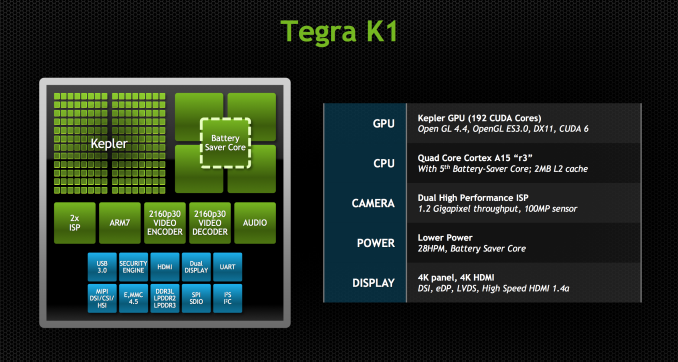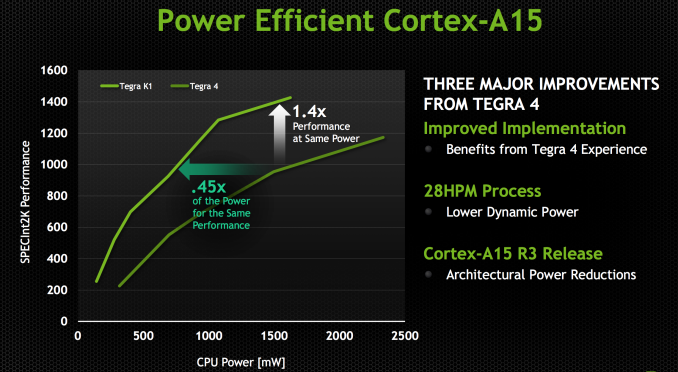NVIDIA Tegra K1 Preview & Architecture Analysis
by Brian Klug & Anand Lal Shimpi on January 6, 2014 6:31 AM EST
NVIDIA has taken to using CES as its platform for launching members of its Tegra mobile SoC family. This year was no different as it shifted branding a bit in its announcement of the Tegra K1, formerly known as Project Logan.
With Tegra 2 NVIDIA’s big selling point was being first to dual-core in Android. Tegra 3 attempted to do the same with being first to quad-core. Tegra 4 just made things faster. Tegra K1 on the other hand does away with the gimmicks and instead focuses on fundamentals.
The SoC will come in two versions, one version with a quad-core (4+1) Cortex-A15, and one that leverages two of NVIDIA’s own 64-bit ARMv8 Denver CPUs. More importantly, they both ship with a full implementation of NVIDIA’s Kepler GPU architecture. In fact, Tegra K1 marks a substantial change in the way NVIDIA approaches mobile GPU design. From this point forward, all mobile GPUs will leverage the same architectures as NVIDIA’s desktop parts. As if that wasn’t enough, starting now, all future NVIDIA GeForce designs will begin first and foremost as mobile designs. NVIDIA just went from playing with mobile to dead serious in a heartbeat.
Tegra K1 will also be NVIDIA's launch vehicle for Project Denver, it's first fully custom ARMv8 CPU core. More on that in a bit.
CPU Option 1: Quad-Core ARM Cortex A15
Tegra K1 will ship in two configurations. The first went into production at the end of December 2013, is shipping to OEMs this quarter and will be in devices, allegedly, in the first half of 2014. This first configuration is based on ARM’s Cortex A15 CPU core.
Much like Tegra 4, the A15 version of Tegra K1 features four Cortex A15s synthesized for high frequencies and a fifth Cortex A15 that’s optimized for low power/frequency operation. The fifth core, what NVIDIA likes to call a shadow or companion core, is swapped in during periods of very low CPU usage (e.g. idle, screen off in your pocket updating new tweets/emails). As CPU demands grow the companion core is switched out for one of the four high performance cores, then two, then three and finally all four can be plugged in at once (but never five).
Tegra K1 ships with a newer revision of the Cortex A15 (r3p3) than what was in Tegra 4 (r2p1). ARM continuously updates its processor IP, with each revision bringing bug fixes and sometimes performance improvements. In the case of Tegra K1’s A15s, the main improvements here have to do with increasing power efficiency. With r3p0 (which r3p3 inherits) ARM added more fine grained clock gating, which should directly impact power efficiency.
The combination of the newer Cortex A15 revision and the move to 28nm HPM give Tegra K1 better performance at the same power consumption or lower power consumption at the same performance level. The reality tends to be that mobile OEMs will pursue max performance and not optimize for a good performance/power balance, but it’s at least possible to do better with Tegra K1 than with Tegra 4.
The max CPU clock goes up from 1.9GHz to 2.3GHz, a direct result of the move to 28nm HPM; 2.3GHz is the max CPU clock regardless of the number of active cores. The max performance increase over Tegra 4 running at max clocks will be just over 20%.
NVIDIA hasn’t made any changes to the L1/L2 cache configuration with Tegra K1. We’re still dealing with a shared 2MB L2 and 32KB/32KB L1s (I$+D$) per core.
The companion core can scale up to 1GHz, but tends to run at around 500MHz.
Feeding the CPU (and GPU) cores is a 64-bit wide LPDDR3 memory interface. NVIDIA will offer Tegra K1 in PoP, discrete and another package revision for standard clamshell notebook use.












88 Comments
View All Comments
HighTech4US - Monday, January 6, 2014 - link
You quoting CharLIE and using his Nvidia hate filled speculative drivel as somehow being gospel taints your article.MrSpadge - Monday, January 6, 2014 - link
He is right, occasionally - you've got to give him that. The problem is you never know before it happens, which makes reading the Inq pretty pointless.HighTech4US - Wednesday, January 8, 2014 - link
A broken clock is right twice a day and wrong the rest of the time which is pretty much charLIE's track record on Nvidia.OreoCookie - Monday, January 6, 2014 - link
If you're familiar the style of The Register and The Inquirer (at least in the past when I was reading them regularly), they often packaged excellent tech reporting in their quirky and snarky way of writing things. (I read both back in the day to learn more about the inner workings of cpu designs and such.) (Charlie Demerjian hails from The Inquirer.) And Anand did not treat Demerjian as gospel, he said that it looks as if he may have been spot on.Xavierx78 - Monday, January 6, 2014 - link
Would really like to see the K1 in the next version of OUYA!silenceisgolden - Monday, January 6, 2014 - link
I'm noticing a lack of talk about LTE/radio support stillfafa1971 - Monday, January 6, 2014 - link
They can bundle a discrete modem, NVIDIA i500 (LTE cat. 4, 150 Mbps):http://www.nvidia.com/object/i500-cellular-modems-...
Rayb - Monday, January 6, 2014 - link
Apparently Nvidia decided to avoid the US market for lack of CDMA. It has been certified for AT&T and will be marketed globally, just not in the US because Verizon/Sprint don't use the GSM baseband.http://www.fiercewireless.com/story/nvidia-not-tar...
Krysto - Monday, January 6, 2014 - link
Decent showing from Nvidia with K1, but the real game-changer will be K2, or whatever the hell they'll call it then, with Denver and Maxwell by default, and made at 16nm FinFET. Hopefully it will arrive no later than early spring next year.Normally that chip should get 700 Gflops, but if they can push another 3x, to 1 TF, that would really give them a lot of buzzwords in the media: "Denver", "Maxwell", "16nm FinFET", "1 Teraflops", etc
I hope they don't blow it. Qualcomm is already getting lazy because they have too much domination in the market. We need another strong competitor.
ddriver - Monday, January 6, 2014 - link
Got to love Shang Tsungs' marketing, K1 - the 192 core chip, now coming with either 2 or 4 cores.